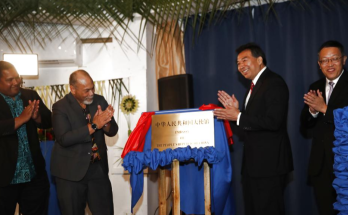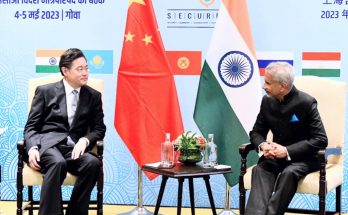
On last Sunday, 25 March, Defence Minister Nirmala Sitharaman told reporters in Dehra Dun that India is “alert and ready for any unforeseen situation in Doklam”. Adding that the government was constantly working to modernise the forces and that they would be ready to “maintain our territorial integrity.”
This was a day after India’a Ambassador to Beijing, Gautam Bambawale, told the South China Morning Post in an interview that any attempt by China to change the status quo along the Indian border may lead to another Doklam-like standoff.
Earlier in the month, Sitharaman had told the Rajya Sabha that the forces of the two countries had redeployed themselves away from the point of the standoff in last June. In response to a question on Chinese activity there, she said that “in order to maintain these troops during winter, PLA has undertaken construction of some infrastructure, including sentry posts, trenches and helipads.”
Ambassador Bambawale’s Saturday statement was nuanced. He did not claim that Indian territorial integrity was the issue, but that “the Chinese military changed the status quo in the Doklam area and therefore India reacted to it. Ours was a reaction to the change in status quo by the Chinese military.”
In this context, he noted that while there had been a resumption of political level communication, there was need to have discussion between the two militaries. Communications between the troops on the ground had resumed, but what was needed was between “the headquarters — say the Central Military Commission in Beijing and the Military Headquarters in New Delhi.”
Why is this area of Doklam, which India considers a part of Bhutan and China claims as its own, “a very very sensitive area,” in the words of Ambassador Bambawale?
The Jampheri ridge, which runs some 6 km east from the Indian boundary, is the southern extremity of Doklam. It provides a clear view of the entire Siliguri Corridor, the narrow ‘chicken’s neck’ connecting India’s mainland to its north-east. Though there is yet another band of Bhutanese territory some 20 km wide as a crow flies between Jampheri ridge and the Corridor, the Indian military views its occupation by the PLA very seriously. Just how much is evident from the fact that Indian army battle plans have long envisaged a military occupation of the ridge in the event of hostilities with China.
New Delhi has had no problems with the occasional PLA patrols to the ridge in the period 2005-2017 but the decision to build a road suggested that the Chinese were planning to permanently occupy the ridge and establish observation posts, and possibly station weapons that could interdict Indian communications in the corridor. That, obviously, has the most serious implications for Indian security.
It is not clear whether Sitharaman and the senior political leadership understand the distinctions in the situation. The dispute over Doklam is between China and Bhutan. The Chinese have encroached upon the area and in 2005, they built a road over Sinche La Pass to the spot where the standoff occurred in June 2017. Thereafter, they would park their vehicles there and patrol a further six to seven kilometres south along the Jampheri ridge, where a Royal Bhutan Army outpost is located . All this was in plain sight and not contested either by India or Bhutan.
Just why they decided to build a motorable road to the Bhutanese post on June 16 last year is not clear, but this came to a halt two days later when Indian troops walked down to the parking point and blocked the road construction. The standoff ended only after the two sides agreed to maintain status quo ante in that area.
Bhutan’s June 29, 2017 press release said that Thimphu had protested the Chinese action in building the road which was a “direct violation of agreements” between the two sides. They were referring to two agreements where the Chinese side had agreed to maintain status quo along the Sino-Bhutan border pending the final settlement of their border issues.
The next day, on 30 June, India issued its own press note defending its intervention in blocking the road construction. It said that it was acting in coordination with the Royal Government of Bhutan but that the issue was not just about the Bhutanese since the Chinese action “would represent a significant change of status quo with security implications for India.”
In his interview, Ambassador Bambawale insisted that there had been no change of status at the so-called “face off site” . But he acknowledged that “maybe behind the Chinese may be putting more military barracks to put in more soldiers.” But in his view, this was “well behind the sensitive area.”
In this context, the most recent reports suggesting that the Chinese may be finding a new alignment for the road to Jampheri ridge, by spanning the Torsa Nullah could undermine the situation. This would be 4-6 kilometres to the east of the spot where last year’s stand-off took place and India would have to mount a serious military operation to block the construction of any road here.
A day after Sitharaman’s statement on 26 March, the Chinese official spokesman Hua Chunying laid out Beijing’s perspective on the issue. She bluntly questioned the Indian Ambassador’s assertion about China changing the status quo of the area. “The Sikkim section of China-India boundary has been demarcated by historical agreements and Dong Lang is China’s territory,” he asserted, adding “There is no such an issue as the change of status quo since China is exercising its sovereignty and conducting other sovereign activities in its own territory”.
So, the situation is poised at a somewhat difficult juncture. If the Chinese do intend to build a road to the ridge and occupy it, the situation will be serious, but India can get militarily involved only if asked to do so by the Bhutanese. As of now, there is no indication that that will happen. Otherwise, the road is open for diplomacy. Ambassador Bambawale’s interview was as clear a signal you can give that India is seeking to go along that path. The question is whether Beijing will reciprocate, or push New Delhi on to a course of confrontation whose consequences could be fraught for all the parties.
Courtesy:ORF
Author Profile
- India Writes Network (www.indiawrites.org) is an emerging think tank and a media-publishing company focused on international affairs & the India Story. Centre for Global India Insights is the research arm of India Writes Network. To subscribe to India and the World, write to editor@indiawrites.org. A venture of TGII Media Private Limited, a leading media, publishing and consultancy company, IWN has carved a niche for balanced and exhaustive reporting and analysis of international affairs. Eminent personalities, politicians, diplomats, authors, strategy gurus and news-makers have contributed to India Writes Network, as also “India and the World,” a magazine focused on global affairs.
Latest entries
 DiplomacyApril 10, 2024Diplomat-author Lakshmi Puri pitches for women power at LSR
DiplomacyApril 10, 2024Diplomat-author Lakshmi Puri pitches for women power at LSR India and the WorldApril 6, 2024UN envoy pitches to take India’s solutions to the world stage
India and the WorldApril 6, 2024UN envoy pitches to take India’s solutions to the world stage CultureApril 5, 2024Youth in Diplomacy: Making it Matter with LSR Model UN 2024
CultureApril 5, 2024Youth in Diplomacy: Making it Matter with LSR Model UN 2024 India and the WorldMarch 28, 2024India to China: Normalization of troops deployment imperative for restoring ties
India and the WorldMarch 28, 2024India to China: Normalization of troops deployment imperative for restoring ties







